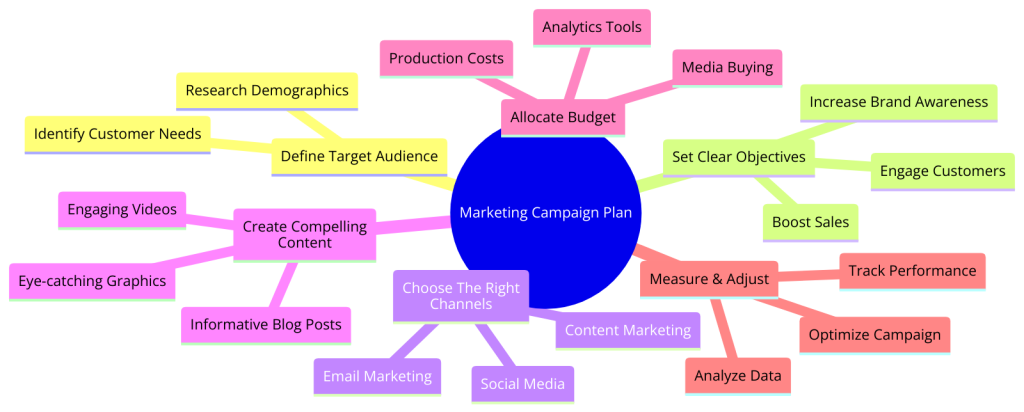Designing a marketing campaign plan involves several key steps to ensure your campaign is targeted, effective, and measurable. Here’s a general outline of the steps you might follow:
Step 1: Define Your Objectives
Defining your objectives is a critical first step in designing a marketing campaign plan, as it sets the foundation for all subsequent decisions and strategies. Here’s a more detailed breakdown of how to define your objectives:
- Start with Your Overall Business Goals: Begin by considering your broader business goals. How can your marketing campaign help achieve these goals? For example, if your business goal is to increase revenue, your marketing objective might be to increase online sales by a certain percentage.
- Use the SMART Criteria
- Specific: Your objectives should be clear and specific, leaving no room for ambiguity. Instead of saying “increase website traffic,” specify “increase website traffic by 20% within the next quarter.”
- Measurable: Ensure that your objectives can be quantified. This allows you to track progress and measure the outcome. For instance, “generate 100 new leads” is a measurable objective.
- Achievable: Your objectives should be realistic and attainable within your resources and time. Setting unattainable goals can demoralize your team and set your campaign up for failure.
- Relevant: Ensure your objectives align with your overall business goals and are relevant to your brand, product, or service. This ensures that your efforts contribute meaningfully to your business’s success.
- Time-bound: Assign a clear deadline to your objectives. This creates a sense of urgency and helps in planning and prioritization. For example, “increase social media followers by 15% in three months.”
- Align with Your Audience and Market: When defining your objectives, consider your target audience and market conditions. Your goals should address your audience’s needs and preferences while considering the competitive landscape and market trends.
- Differentiate Between Primary and Secondary Objectives: Identify your primary objective, your main campaign goal. You can also have secondary objectives, which are additional goals that support the primary one or contribute to other aspects of your business. For instance, your primary purpose is to increase sales, while a secondary objective is to improve customer engagement.
- Consider Various Aspects of Marketing: Your objectives can cover different aspects of marketing, such as raising brand awareness, generating leads, increasing customer engagement, boosting sales, or promoting a new product or service. Choose objectives that best serve your current business needs.
- Get Input from Key Stakeholders: Involve key stakeholders in the objective-setting process to ensure alignment and buy-in across your organization. Different perspectives can enrich your objectives, making them more comprehensive and attainable.
- Document and Communicate Your Objectives: Document and communicate your objectives to everyone involved in the campaign. This ensures all team members are aligned and working towards the same goals.
Step 2: Understand Your Target Audience
Understanding your target audience is crucial for designing a marketing campaign that resonates with potential customers and drives desired actions. Here’s a more detailed approach to understanding your target audience:
- Conduct Audience Research
- Demographic Information: Gather basic demographic information about your potential customers, such as age, gender, income, education, and occupation. This information provides a general overview of who your audience is.
- Psychographics: Dive into psychographics, which includes interests, hobbies, values, attitudes, and lifestyles. Understanding these aspects helps you tailor your messaging and campaigns to align with your audience’s beliefs and preferences.
- Behavioral Data: Analyze behavioral data, such as purchase history, browsing behavior, and product usage patterns. This data helps you understand what drives your audience’s actions and how they interact with your brand or similar products.
- Create Buyer Personas: Develop detailed buyer personas that represent your ideal customers. Personas are fictional characters created based on your research that embody the characteristics of your target segments. Include demographic details, goals, pain points, and buying behavior in your personas to bring them to life.
- Understand Pain Points and Needs: Identify the challenges, problems, and needs your target audience faces that your product or service can address. Understanding these pain points allows you to position your offering as a solution in your marketing messaging.
- Analyze Customer Feedback and Engagement:
- Collect and analyze feedback from existing customers through surveys, reviews, and social media engagement. This feedback can provide insights into what your audience appreciates about your product or service and what areas need improvement.
- Monitor social media conversations and forums related to your industry to understand the topics and issues that matter most to your target audience.
- Segment Your Audience: Divide your audience into smaller segments based on shared characteristics or behaviors. This allows for more targeted and effective marketing efforts. For example, you might have segments based on different use cases for your product, geographic locations, or customer lifecycle stages.
- Keep Up with Trends and Changes: Stay informed about trends and changes in your target audience’s preferences and behaviors. The market and consumer interests can evolve, and keeping abreast of these changes helps you adapt your strategies accordingly.
- Utilize Analytics Tools: Use analytics tools, such as Google Analytics, social media analytics, and customer relationship management (CRM) systems, to gather data on your audience’s online behavior. These tools provide valuable insights into how your audience interacts with your website and content.
- Engage Directly with Your Audience: Engage directly with your audience through social media, community events, or customer service interactions. Direct engagement provides qualitative insights that can complement your quantitative data, giving you a fuller picture of your audience.
Step 3: Analyze Your Market and Competitors
Analyzing your market and competitors is critical in developing an effective marketing campaign plan. This analysis helps you understand the competitive landscape, identify opportunities and threats, and refine your strategy to differentiate your offering. Here’s how to conduct a thorough market and competitor analysis:
- Market Analysis
- Industry Trends: Keep track of broader industry trends that could impact your business. This includes technological advancements, regulatory changes, shifts in consumer behavior, and economic factors.
- Market Size and Growth: Estimate the size of your target market and its growth potential. Understanding the market’s size helps you assess its opportunity, while the growth rate indicates its future potential.
- Market Segments: Identify and analyze different market segments within your target market. Understanding the nuances of each segment allows for more targeted and effective marketing strategies.
- Customer Needs and Preferences: Continuously monitor changes in customer needs, preferences, and expectations. Staying attuned to these changes can help you adapt your product and marketing strategies to meet customer demands better.
- Competitor Analysis:
- Identify Key Competitors: Make a list of your direct and indirect competitors. Direct competitors offer products or services similar to yours, while indirect competitors offer alternatives that meet the exact customer needs.
- Analyze Competitors’ Strategies: Examine your competitors’ product offerings, pricing strategies, marketing tactics, distribution channels, and customer service. Understanding their strategies can help you identify their strengths and weaknesses.
- SWOT Analysis: Conduct a SWOT (Strengths, Weaknesses, Opportunities, Threats) analysis for each major competitor. This analysis helps you understand where your competitors are positioned in the market and where opportunities or threats to your business might exist.
- Benchmarking: Compare your products, services, and marketing strategies against your competitors. Benchmarking can help you identify areas for improvement and potential competitive advantages.
- Differentiation Opportunities: Based on your market and competitor analysis, identify opportunities to differentiate your offering. This could be through unique product features, superior customer service, innovative marketing strategies, or more competitive pricing.
- Monitor Competitor Activity: Set up processes to continuously monitor competitor activity, such as new product launches, marketing campaigns, or changes in pricing. Tools like Google Alerts, social media monitoring platforms, and competitor analysis software can help.
- Customer Feedback: Gather and analyze customer feedback on your competitors’ products and services. This can provide insights into what customers value and any gaps your product or service could fill.
- Assess Market Position: Evaluate your current position in the market relative to your competitors. Understanding your market share and brand perception can help you set realistic goals for your marketing campaign.
- Regulatory Environment: Stay informed about the regulatory environment in your industry and market. Regulations can impact your marketing strategies and competitive dynamics.
Step 4: Set Your Budget
Setting your budget is a critical step in the planning process of a marketing campaign, as it defines the scope of what you can achieve and how extensively you can reach your target audience. Here’s a detailed approach to setting your marketing campaign budget:
- Align Budget with Objectives: Start by revisiting your campaign objectives. More ambitious goals typically require a larger budget. For example, a nationwide campaign aiming for a significant increase in brand awareness will naturally require more resources than a local campaign focused on a small, niche audience.
- Review Past Campaigns: Analyze the budgets and outcomes of past marketing campaigns. What was the return on investment (ROI)? Which channels and tactics were most cost-effective? Learning from past experiences can guide your budget allocation and help you avoid previous mistakes.
- Consider All Potential Costs:
- Media Spend: This includes costs for ad placements on social media, search engines, traditional media, and other platforms.
- Content Creation: Budget for creating campaign content, such as graphics, videos, blog posts, and other marketing materials.
- Technology and Tools: Consider the costs of marketing automation tools, CRM systems, analytics platforms, and other software that might be necessary for your campaign.
- Personnel: Include staffing costs, whether in-house team members or external agencies and consultants.
- Other Expenses: Don’t forget to account for miscellaneous costs such as printing, event sponsorship, promotional items, and any legal or licensing fees.
- Determine Your Marketing Channels: Decide which channels (digital, print, events, etc.) you’ll use for your campaign. Different channels have different cost structures. Digital channels, for instance, can be more flexible and adjustable, while traditional channels like TV or print may require a more significant upfront investment.
- Set a Flexible Budget: While having a fixed budget is essential, it’s equally important to remain flexible. Set aside a contingency fund (usually 5-10% of your total budget) for unforeseen opportunities or adjustments that may arise during the campaign.
- Calculate Customer Acquisition Cost (CAC): Understand how much you’re willing to spend to acquire a new customer. This will depend on your product’s price, the lifetime value of a customer (LTV), and your gross margins. Your CAC should be a fraction of your LTV to ensure profitability.
- Prioritize Spending: Allocate your budget based on the channels and tactics most likely to achieve your objectives and effectively reach your target audience. Prioritize high-ROI activities, especially if you’re working with a limited budget.
- Establish a Monitoring Plan: Plan how to monitor spending and performance throughout the campaign. This will allow you to make real-time adjustments, redirecting funds from underperforming areas to those delivering better results.
- Consider the Sales Cycle: If your product or service has a long sales cycle, your budget might need to account for longer-term marketing efforts to nurture leads.
- ROI Expectations: Set clear expectations for the return on investment. Understanding the expected outcomes regarding sales, leads, or other KPIs can help justify the budget and set performance benchmarks.
Step 5: Choose Your Channels and Tactics
Choosing the right channels and tactics for your marketing campaign is essential for reaching your target audience effectively and achieving your campaign objectives. This decision should be informed by understanding your audience, your campaign goals, and your budget constraints. Here’s how to approach this step:
- Match Channels with Your Audience: Identify where your target audience spends their time. Are they active on certain social media platforms? Do they prefer email communication? Are they more likely to engage with traditional media such as TV, radio, or print? Use your audience research to determine which channels will most likely reach your target demographic and psychographic profiles.
- Consider Your Campaign Objectives: Different channels excel at achieving different objectives. For example, social media is excellent for building brand awareness and engaging with your audience, while email marketing can be highly effective for lead nurturing and customer retention. PPC (Pay-Per-Click) advertising and SEO (Search Engine Optimization) are powerful for driving targeted traffic and sales.
- Align with Your Budget: The chosen channels should align with your budget constraints. Digital channels like social media, content marketing, and email can be cost-effective and offer flexible budgeting options. Traditional channels like TV or print require a higher investment, so they are only feasible if your budget allows.
- Leverage Multi-Channel Strategies: Consider using a multi-channel approach to maximize reach and impact. Combining several channels can enhance the effectiveness of your campaign by reinforcing your message across different touchpoints. However, ensure that your messaging is consistent and tailored to the specifics of each channel.
- Explore Emerging Channels and Technologies: Stay informed about new channels and technologies. Platforms like TikTok or new features in existing platforms (e.g., Instagram Reels) can offer fresh opportunities to reach your audience, often with less competition.
- Utilize Content Marketing: Content marketing can be a powerful tactic across various channels. Creating valuable and relevant content that addresses the needs and interests of your audience can attract, engage, and retain customers. This could include blog posts, videos, infographics, podcasts, and more.
- Consider the Customer Journey: Choose channels and tactics that cater to different stages of the customer journey, from awareness to consideration to decision. For example, content marketing and social media can create awareness, while targeted email and retargeting ads can convert interest into action.
- Test and Learn: Be prepared to test different channels and tactics to see what works best for your audience and objectives. Use A/B testing and analytics to measure performance and continually refine your approach.
- Integrate Offline and Online Channels: If applicable, consider how offline channels (like events, direct mail, or in-store promotions) can work with online channels to create a cohesive and comprehensive campaign.
- Prioritize Engagement and Interaction: Choose channels for engagement and interaction with your audience. Two-way communication can build stronger relationships and provide valuable insights into your audience’s preferences and feedback.
Step 6: Create Compelling Content and Messaging
Creating compelling content and messaging is essential for engaging your target audience and driving the success of your marketing campaign. This involves crafting messages that resonate with your audience, highlight the value of your offering, and differentiate your brand from competitors. Here’s a detailed approach to creating content and messaging that captivates and converts:
- Understand Your Audience: Understand your target audience’s needs, pain points, preferences, and language. Use this insight to create messages that speak directly to them, addressing their specific concerns and desires.
- Define Your Value Proposition: Clearly articulate what makes your product or service unique and why it matters to your audience. Your value proposition should be the core message around which your content and campaign are built, highlighting the benefits and solutions your offering provides.
- Develop a Consistent Brand Voice: Your brand voice should reflect your brand personality and be consistent across all content and messaging. Whether professional, friendly, authoritative, or playful, ensure it resonates with your target audience and remains consistent across all channels and content.
- Tailor Content to the Channel: Adapt your messaging and content format to fit your specific channel. For example, social media content should be more engaging and visually driven, while blog posts can be more detailed and informative. Ensure that the core message remains consistent, but tailor the delivery to suit the platform and its audience.
- Use Storytelling: Incorporate storytelling into your content to make it more engaging and memorable. Stories can help illustrate your value proposition in a relatable way, making complex information more digestible and emotionally appealing.
- Focus on Benefits, Not Features: Highlight the benefits of your product or service rather than just listing features. Show your audience how your offering can solve their problems, improve their lives, or help them achieve their goals.
- Create a Clear Call-to-Action (CTA): Every piece of content should have a clear and compelling call-to-action that guides the audience on what to do next. Whether learning more, signing up, purchasing, or contacting your business, your CTA should be unmistakable and relevant to the content.
- Use Visuals and Multimedia: Enhance your messaging with visuals and multimedia elements like images, videos, infographics, and interactive content. Visual content can increase engagement, make complex information easier to understand, and leave a lasting impression on your audience.
- Test and Optimize: Continuously test different messages, headlines, visuals, and formats to see what resonates best with your audience. Use A/B testing and analytics to gather data and refine your approach based on what works.
- Maintain Relevance and Timeliness: Ensure your content is relevant to your audience’s current trends, challenges, and interests. Timeliness can make your content more relatable and increase its impact.
- Leverage User-Generated Content and Testimonials: Incorporate user-generated content, testimonials, and success stories into your campaign to build trust and credibility. Authentic experiences shared by real users can be powerful persuaders.
Step 7: Plan Your Timeline
Planning your timeline is crucial in organizing and executing a successful marketing campaign. A well-defined timeline helps ensure that every aspect of the campaign is carried out promptly, allowing for the coordination of various elements and stakeholders. Here’s how to effectively plan your campaign timeline:
- Define Campaign Duration: Decide your campaign’s start and end dates. Consider factors like seasonality, industry events, and sales cycles that impact the effectiveness of your campaign. The duration should allow enough time to achieve your objectives, but be concise enough to maintain momentum and urgency.
- Break Down the Campaign into Phases: Segment your campaign into critical phases such as planning, creation, execution, monitoring, and analysis. Breaking the campaign into manageable parts makes assigning tasks, setting deadlines, and tracking progress easier.
- Set Milestones: Establish major milestones within your timeline. These could include the completion of the creative assets, the launch of the campaign, key promotional events, and the final analysis of the campaign’s performance. Milestones help to keep the team focused and provide points for evaluating progress.
- Allocate Time for Research and Development: Include time at the beginning of your timeline for market research, audience analysis, and strategy development. This foundational work is essential for informing the direction and content of your campaign.
- Schedule Content Creation and Approval: Schedule time for creating campaign content, including copywriting, design, and multimedia production. Also, factor in time for revisions and approvals to ensure content aligns with your brand standards and campaign objectives.
- Plan for Channel Preparation: Allocate time to prepare and optimize the chosen marketing channels. This might include setting up ad accounts, creating landing pages, or optimizing social media profiles.
- Incorporate Lead Time for External Partners: If you’re working with external partners, such as advertising platforms, influencers, or creative agencies, consider their lead times and deadlines in your timeline to ensure they can deliver as needed.
- Allow Flexibility for Testing: Include time for testing different aspects of your campaign, such as A/B testing ad copy or layouts. Testing can provide valuable insights that improve campaign performance but requires time to execute and analyze results.
- Set Aside Time for Monitoring and Adjustments: Schedule regular check-ins once the campaign is live to monitor its performance against your objectives. This allows you to make timely adjustments to optimize the campaign’s effectiveness.
- Schedule a Post-Campaign Analysis: After the campaign concludes, plan a comprehensive review to analyze its performance, gather insights, and document learnings for future campaigns. This should include a review of KPIs and ROI and discussing what worked well and what could be improved.
- Use Project Management Tools: Utilize project management tools and software to create and manage your timeline. These tools can help you assign tasks, set reminders, and visualize your schedule, making it easier to keep the campaign on track.
- Communicate the Timeline: Share the timeline with all team members and stakeholders involved in the campaign to ensure everyone is aligned and understands their responsibilities and deadlines.
Step 8: Implement and Execute
The implementation and execution phase is where your marketing campaign plan comes to life. This stage involves putting all your planning and preparation into action. Managing this phase effectively ensures your campaign runs smoothly and meets its objectives. Here’s how to approach the implementation and execution of your marketing campaign:
- Finalize Creative Assets: Ensure all creative assets, including graphics, videos, copy, and other content, are finalized, approved, and aligned with your campaign’s messaging and objectives. This includes ensuring that all assets are formatted correctly for your platforms and channels.
- Set Up Campaign Infrastructure: Prepare the technical and logistical infrastructure needed for your campaign. This might involve setting up landing pages, configuring email automation sequences, creating ad accounts, or scheduling social media posts. Ensure that tracking mechanisms, such as UTM parameters or conversion pixels, are in place to accurately measure the campaign’s performance.
- Launch the Campaign: Initiate the launch of your campaign according to your planned timeline. This might involve publishing your content, activating your ads, sending emails, or kicking off an event. Ensure that all elements go live as scheduled and are functioning correctly.
- Monitor Performance in Real-Time: Once the campaign is live, closely monitor its performance to ensure everything is running as expected. Keep an eye on critical metrics aligning with your objectives, such as website traffic, conversion, engagement, and sales figures. Use tools and dashboards that provide real-time data to stay informed.
- Engage with Your Audience: Actively manage and engage with your audience throughout the campaign. Respond to comments, answer questions, and interact with your audience on social media and other platforms. This engagement can enhance the campaign’s impact and foster a positive relationship with your audience.
- Make Adjustments as Needed: Be prepared to adjust your campaign based on performance data and audience feedback. This might involve reallocating your budget to more effective channels, tweaking your messaging, or addressing technical issues. Flexibility is key to maximizing the campaign’s effectiveness.
- Coordinate Across Teams: Ensure that all teams involved in the campaign, from marketing to sales to customer service, are coordinated and informed. Regular updates and communication can help align efforts and quickly address emerging challenges.
- Maintain Consistency: Keep your campaign messaging and branding consistent across all channels and touchpoints. Consistency helps reinforce your message and enhances brand recognition.
- Document Progress and Learnings: Keep detailed records of the campaign’s implementation, including any challenges encountered, adjustments made, and lessons learned. This documentation will be valuable for analyzing the campaign’s performance and planning future campaigns.
- Stay Compliant: Ensure that all aspects of your campaign comply with legal regulations and industry standards, especially regarding data privacy, advertising standards, and intellectual property.
Step 9: Monitor and Adjust
Monitoring and adjusting your marketing campaign in real time is crucial for maximizing its effectiveness and ensuring it meets its objectives. This phase involves closely tracking the campaign’s performance against key metrics and making informed adjustments to improve results. Here’s how to approach this critical step:
- Set Up Key Performance Indicators (KPIs): Before the campaign launches, identify the key performance indicators (KPIs) to measure its success. These should align with your campaign objectives and include metrics like website traffic, conversion rates, engagement rates, lead generation, and sales figures.
- Use Real-Time Analytics Tools: Leverage real-time analytics tools to continuously monitor your campaign’s performance. Tools like Google Analytics, social media analytics, and ad platform dashboards can provide valuable insights into how your campaign is performing across different channels.
- Schedule Regular Check-Ins: Establish a schedule for regular check-ins to review campaign data. This could be daily, weekly, or at another frequency that makes sense for the pace of your campaign. Use these check-ins to assess performance and identify areas that may need adjustment.
- Monitor Audience Engagement: Monitor how your audience engages with your campaign. Pay attention to comments, shares, likes, and direct feedback. Audience engagement can provide qualitative insights that complement the quantitative data from analytics tools.
- Be Prepared to Pivot: If certain aspects of your campaign are not performing as expected, be prepared to make strategic adjustments. This might involve reallocating your budget, tweaking your messaging, changing your targeting parameters, or even pausing underperforming elements of the campaign.
- Optimize for High Performance: Identify the highest-performing aspects of your campaign and consider allocating more resources to these areas. For example, if certain ads or channels yield better results, increasing your investment in these areas can enhance your campaign’s effectiveness.
- Test and Iterate: Use A/B testing to experiment with different variables within your campaign, such as headlines, call-to-action buttons, images, or landing pages. A/B testing can help you identify the most effective elements and optimize your campaign for better results.
- Maintain Communication with Stakeholders: Keep all stakeholders, including team members and partners, informed about the campaign’s performance and any adjustments made. Clear communication ensures everyone is aligned and can contribute to the campaign’s success.
- Document Adjustments and Outcomes: Keep detailed records of any adjustments made to the campaign and the outcomes of those changes. This documentation will be invaluable for understanding what worked, what didn’t, and why, providing insights for future campaigns.
- Stay Customer-Centric: Always keep your target audience’s needs and preferences at the forefront of any adjustments you make. Ensuring that your campaign continues to resonate with and provide value to your audience is key to its success.
Step 10: Evaluate and Learn
Evaluating and learning from your marketing campaign is a critical final step that provides insights into its effectiveness and informs future marketing efforts. This process involves thoroughly analyzing the campaign’s performance, understanding what worked, what didn’t, and why, and then applying these learnings to future campaigns. Here’s how to approach the evaluation and learning phase:
- Review Campaign Objectives and KPIs: Revisiting your initial campaign objectives and the key performance indicators (KPIs) you set to measure success. This will provide a framework for evaluating the campaign’s performance.
- Collect and Analyze Data: Gather comprehensive data from all the tools and platforms you used during the campaign, including website analytics, social media analytics, email marketing metrics, sales data, and other relevant sources. Analyze this data to assess how well the campaign met its objectives.
- Measure ROI: Calculate the return on investment (ROI) of the campaign by comparing the gains (in terms of revenue, leads, brand exposure, etc.) against the costs. Understanding the ROI will help you gauge the campaign’s financial success and inform budgeting decisions for future campaigns.
- Conduct a SWOT Analysis: Perform a SWOT (Strengths, Weaknesses, Opportunities, Threats) analysis of the campaign to identify its strong points, areas for improvement, opportunities for future marketing efforts, and external factors that could impact future campaigns.
- Gather Stakeholder Feedback: Collect feedback from all stakeholders involved in the campaign, including team members, partners, and customers. This feedback can provide valuable insights into the campaign’s effectiveness and areas that may not be apparent from quantitative data alone.
- Identify Key Learnings: Based on your data analysis and feedback, identify key learnings about what worked well and what didn’t. This might include insights about messaging, channel effectiveness, targeting accuracy, creative elements, and operational aspects like timing and coordination.
- Document Best Practices and Areas for Improvement: Compile a list of best practices that contributed to the campaign’s success and should be replicated in future campaigns. Similarly, note down areas for improvement and potential strategies to address these in the future.
- Share Learnings with the Team: Organize a debrief session with your team and relevant stakeholders to share the evaluation outcomes. Discuss the key learnings, best practices, and areas for improvement, ensuring that everyone involved can benefit from these insights.
- Create an Action Plan for Future Campaigns: Use the insights from the evaluation to create an action plan for future marketing efforts. This should include specific strategies to replicate successes and address areas for improvement.
- Maintain a Culture of Continuous Improvement: Foster a continuous learning and improvement culture within your team. Encourage an open, constructive discussion about successes and failures and emphasize the value of learning from every campaign.












